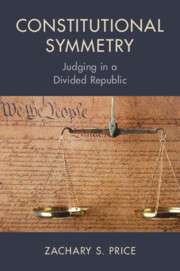Constitutional Symmetry

I’m grateful to Eugene and the other Volokh Conspiracy bloggers for hosting these guests posts on my new book, Constitutional Symmetry: Judging in a Divided Republic.
As readers may have noticed, the United States is closely divided over politics, and each political coalition advances a distinct constitutional vision that largely aligns with its political objectives.
Conservatives interpret the Constitution to protect religion, limit gun control, and obstruct federal administrative governance while allowing state-level regulation of moral questions like abortion. Progressives see a mirror-image constitution that advances social justice, confers broad federal power, and allows flexible administrative regulation while limiting state and local police authority and guaranteeing sexual and reproductive autonomy. As national politics have grown divided and polarized, achieving partisan goals through federal legislation has grown more difficult, so the two parties have dreamed, in effect, of capturing the courts and implementing their vision through constitutional interpretation instead.
This dynamic is not new and has existed at other times in the past, but it is perilous. It treats a document that should be source of shared commitments and stable ground rules as a vehicle for extending political conflict.
The book urges judges and justices to resist this constitutional polarization. It also offers them a specific means of doing so: judges should favor, when possible, constitutional understandings that are not politically one-sided but instead operate symmetrically, meaning that they offer valuable protections to interests on opposite sides of key current divides.
What would favoring such symmetry mean concretely? The First Amendment principle of content (or viewpoint) neutrality provides a good example. By protecting all speakers, no matter what they are saying, this understanding of expressive freedom ensures that those disappointed by the result in one case may equally benefit from the decision’s rationale in future cases. The anti-commandeering doctrine from the federalism context provides another good example. By shielding state and local officials from compelled administration of federal laws, this doctrine equally protects “blue” states during a Republican presidential administration and “red” states during a Democratic one.
By contrast, the Court’s decisions recognizing an individual right to bear arms are paradigmatic examples of asymmetry: they effectively constitutionalize one side of the fraught political and social divide over gun control.
These decisions’ asymmetry does not necessarily mean that they are wrong. I do not argue that symmetric understandings should always prevail; my argument is instead that judges and justices should prefer symmetric understandings whenever their primary interpretive commitments allow them to do so. The Second Amendment example, however, does illustrate why this orientation is valuable. Whether or not decisions like Heller and Bruen are legally sound, they are costly: they alienate roughly half the country from the constitutional law that govern us all.
In subsequent posts, I will discuss theoretical justifications for this preference. Indeed, I will argue that it is already an inchoate feature of constitutional interpretation. I will also discuss concrete positions that this orientation should lead judges to favor. Among other things, the book argues that symmetry supports disfavoring religion-specific theories of civil liberty, limiting the major questions doctrine in administrative law, and allowing limited and indirect forms of race-consciousness in governmental decision-making. At the same time, it defends the post-Dobbs approach to substantive due process as potential symmetric, highlighting parental rights as a key example, and it likewise defends the Court’s combined decisions allowing political gerrymanders and rejecting the independent state legislature theory.
To set the stage for those posts, let me just elaborate briefly here on the political context to which symmetry responds.
Over roughly the last half century, American politics have come to be organized around close competition between two ideologically cohesive parties that compete nationally at near parity. As a result, legislative gridlock and bare-knuckle maneuvering have become the norm within Congress, and during periods of divided government the two political branches have frequently been at loggerheads. At the same time, judicial appointments have become increasingly political. According to an important recent study, the period since 2010 is the first time in American history when all Supreme Court justices appointed by presidents from one party are identifiably distinct from those appointed by presidents in the opposite camp.
This is a bad combination. On the one hand, the intensity of our political conflicts makes credibly settling legal disputes and enforcing constitutional ground rules more important than ever. On the other hand, those same political forces have undermined the courts’ standing as comparatively neutral and trustworthy arbiters of those very sorts of conflicts. As recent events including the January 6 riot and other instances of election denial show, the risk that some charged constitutional conflict will spin out of control is no longer entirely hypothetical.
Did the election this month alter this picture? Probably not.
I appreciate that some Volokh readers are happily drinking liberal tears at the moment and dreaming of perpetual dominance. But the pattern in recent decades has been for each side to overreach when it gains power, provoking a backlash that delivers power back the other way. This time might be different, but I wouldn’t bet the house on it. Donald Trump just barely won 50 percent of the popular vote and (in an election with comparatively low turnout, especially in Democratic-leaning areas) he appears to have won the popular vote by a smaller number of voters than either George W. Bush in 2004 or Joe Biden in 2020, to say nothing of Barack Obama in 2008 and 2012—and none of those elections ended the era of polarization and partisanship.
In any event, despite the GOP’s electoral victory, the country remains closely divided, and President Trump himself is a divisive figure, to put it mildly. Roughly half the country will soon feel quite alienated from its government (just as Republicans did during the previous four years), and the Supreme Court—having stymied key Biden initiatives, kept Donald Trump on the ballot, and immunized him against some attempted prosecutions—is widely perceived as aligned with the GOP’s agenda. The stage is thus set for constitutional law to remain a vector of division instead of the unifying source of stability that the moment calls for.
The good news is that many judges seem to appreciate this dilemma. Judges worthy of the name do not want to be remembered as result-driven partisans; they take seriously their responsibility to act as impartial stewards of the law. Some have even worried aloud about the challenges of navigating a polarized environment.
Judges, though, need better tools for managing these challenges. In a happy alignment of constitutional virtue and judicial self-interest, a preference for symmetry can provide just that, as I will explain in subsequent posts.
The post Constitutional Symmetry appeared first on Reason.com.
